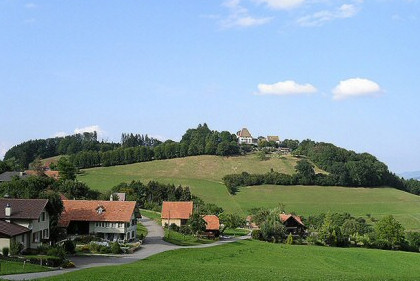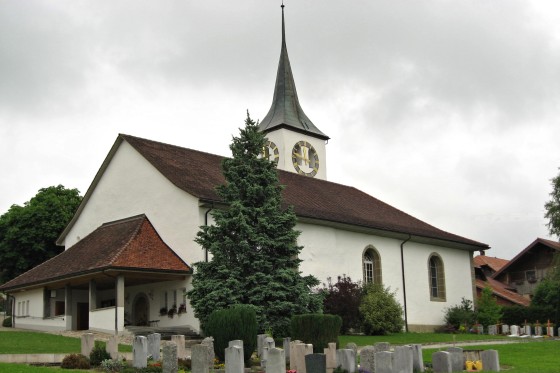From Wattenwil the path leads uphill past the church (pilgrims' stamp) standing next to the old schoolhouse.
Here a view back to Wattenwil and the church.
The path shortly after Wattenwil

It always leads uphill to Burgistein village. Opposite on a hilltop, Burgistein Castle, built around 1260, looks over to us. It was rebuilt after being destroyed in the Laupen War in 1336. From 1493 to 1690 it belonged to the mayor of Bern, Jakob von Wattenwyl, who undertook major renovations during his time.
For a larger view touch the picture with the mouse
Note for photoshop fans: When zooming in, the castle will become bigger, but the clouds will not get bigger!
Farm in Weierboden
After Burgistein in the village part "Bim Weier" (at the pond) we reach the highest point and continue our pilgrimage through a flat meadow high valley, past beautiful farm settlements, to Riggisberg.
At the entrance to Riggisberg you can see Riggisberg castle, built around 1700 by Albrecht von Erlach, on a hill. Today it is used as a dormitory. Above the centre of the village with its beautiful castle park is the old Riggisberg church. It was originally consecrated to Saint Sebastian. A new nave was added to the late Romanesque choir tower of the parish church in 1687, which was replaced by an even larger one in 1939 and 1979.
The romanesque tower:

We continue to walk up a natural road and follow a chain of hills to the west. If the weather would have allowed it, we would have had a magnificent view of the Bernese Alps and the Gantrisch region, so we had to be content with the view of the vast hilly landscape of the Schwarzenburgerland.

The Way of St. James leads past the Martinskirche Rüeggisberg. Parts of the west and south walls of the early Romanesque building (10th-11th centuries) have been preserved with tower foundations on the south side of the church. The foundation is said to date back to Queen Bertha of Burgundy.

In Rüeggisberg we meet the famous monastery ruins. The once important site of the former Cluniac priory was once an important place of refuge for pilgrims. The history of the monastery dates back to 1072.

